Charged for Action: The Hidden Secrets of AEX Oligonucleotide Analysis
Oligonucleotides — short strands of DNA or RNA — are essential in modern molecular biology, playing a vital role in diagnostics, therapeutics and genetic research. But before these powerful molecules can be trusted in the lab or clinic, they must be thoroughly analyzed for purity, sequence integrity, and structural modifications.
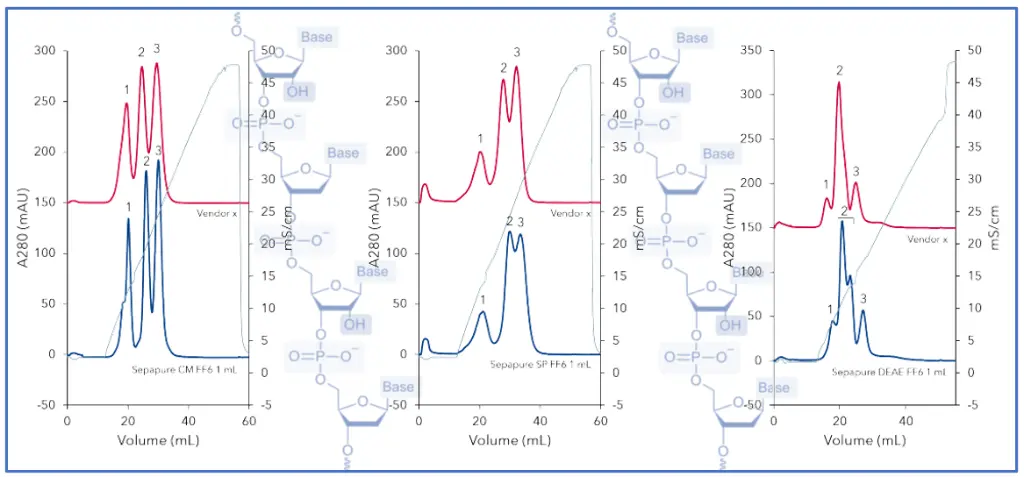
💡How Do Scientist Decode Oligonucleotides?
Understanding the fundamentals of Anion Exchange Chromatography (AEX) in oligonucleotide analysis opens the door to more accurate, reproducible, and insightful results. It is one of the most widely used and powerful analytical methods for assessing Oligonucleotide quality and a technique that separates oligonucleotides based on their negative charge, which is directly related to their length and sequence composition. In the following the details how it works, and why it matters.
💡How Oligos Stick or Slip: The Smart Science of Ion Exchange Chromatography (IEX)?
First of all, we have to understand the approach of ion exchange chromatography. Oligonucleotides possess a negatively charged phosphate backbone. In IEX, this charge becomes the basis for separation. The key components of IEX include:
- Stationary phase (Resin): A charged surface (typically quaternary amine functional groups for oligonucleotides) that binds charged molecules.
- Mobile phase: A buffer system, usually aqueous with a salt gradient (commonly NaCl or KCl), is used with the key function to maintain the pH and the charge state of the analyte as well as to control the elution strength.
The elution order is determined by analyte charge. Weakly charged analytes elute early and highly charged analytes interact more intensively and stronger with the stationary phase so that they elute later (see figure 1).
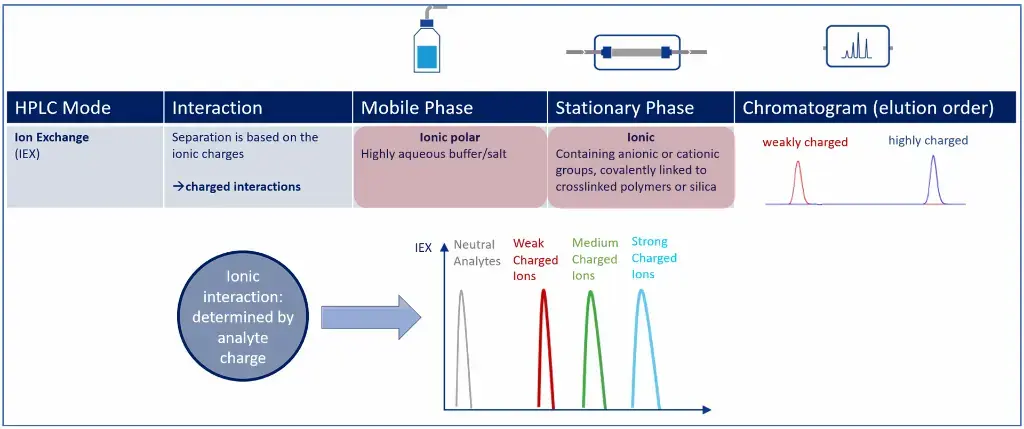
Figure 1: IEX overview including elution order dependency on analyte charge.
The procedure of ion exchange chromatography is following a five-step rule (see also figure 2).
Step 1 – Equilibration: Equilibration involves washing the column with start buffer until baseline and pH stabilize, ensuring ionizable groups are ready to interact with charged analytes. Samples should be dissolved in the start buffer before loading.
Step 2 – Sample loading/adsorption: In the typical adsorption step, the pH and ionic strength of the buffer are adjusted such that the analytes bind to the column while impurities do not.
Step 3 – Wash: The washing step uses start buffer to remove uncharged molecules. Baseline stabilizes as impurities are washed away.
Step 4 – Elution: A salt or pH gradient is used to elute bound analytes, as buffer ions displace them from charged sites on the column. Weakly bound analytes elute at low ionic strength, while more and highly charged molecules elute as salt concentration increases.
Step 5 – Regeneration: The column is regenerated by flushing with a high ionic strength buffer to remove bound molecules, followed by reconditioning with the starting buffer until the baseline and pH of the eluent stabilize before the next run.
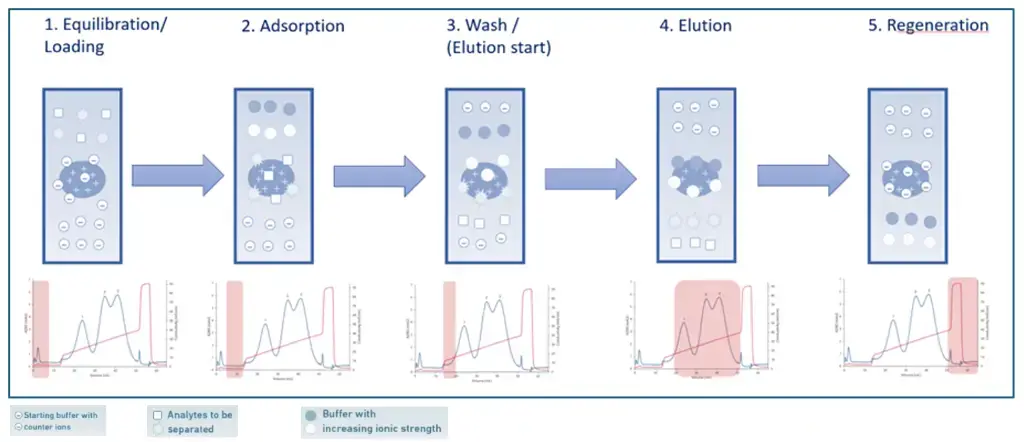
Figure 2: Five steps of IEX procedure (in blue), outlined using an example chromatogram (in red).
💡Oligos on the Move: The Magic of AEX Separation for Oligonucleotides
The repeating phosphate backbone, where each phosphate group carries a negative charge at physiological or analytical pH (7–9) gives rise to a strong, predictable anionic character. Negatively charged oligonucleotides bind electrostatically to the positively charged anion exchange resin, which can be classified as strong or weak based on functional groups and pH range (see figure 3).
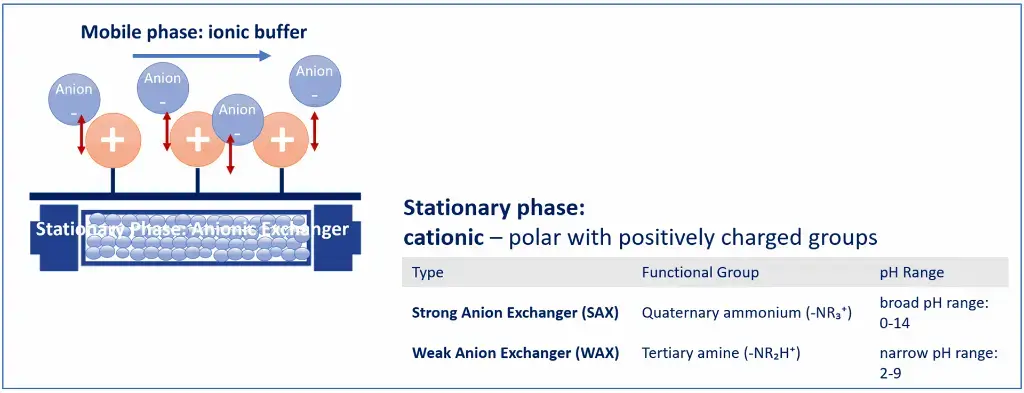
Figure 3: Ionic interactions and pH influence on Anion Exchange Chromatography (AEX).
The most used mobile phase additives are displayed and often combined with salts for controlling elution strength. A typical mobile phase setup in anion exchange mode is shown in figure 4.

Figure 4: AEX buffer selection and gradient strategy (chromatogram with red buffer gradient curve).
The applied salt gradient with increasing concentration of salt ions (Cl⁻ or similar) competes with the backbone of oligonucleotides for binding to the anion exchanger resin. The elution profile of oligonucleotides is influenced by:

💡AEX and Oligos: A Perfect Match – But why?
Anion Exchange Chromatography (AEX) is the first choice for oligonucleotide purification in preparative mode. AEX offers high resolution, making it ideal for detecting impurities, truncated sequences, or closely related variants — even those differing by a single nucleotide.
Strong and uniform negative charge: The overall charge scales with the length of the oligonucleotide — longer oligos have more phosphate groups, hence more negative charge. This consistent charge pattern makes oligos ideal candidates for charge-based separation.
High selectivity based on charge density: While separation by sequence alone is less pronounced than by length, AEX can resolve some sequence-specific variations due to minor differences in local charge density and structure.
Gradient elution enhances resolution: AEX typically uses a salt gradient (e.g., increasing NaCl or KCl concentration) to elute bound oligonucleotides. The gradient gives excellent control over separation and allows precise tuning to resolve closely related oligos.
--> Weakly bound impurities (short or degraded Oligos) elute at lower salt concentrations.
--> Full-length products with higher charge elute later, at higher ionic strengths.
Linearity and predictability: Retention time correlates linearly with oligonucleotide length in many cases. This makes it easy to identify and quantify impurities, such as n−1 or n−2 species.
Applicable to a wide range of modifications: Modified oligonucleotides still retain their anionic character. AEX can often resolve these modifications or their related impurities, even if the mass differences are small.
To conclude our deep dive into anion exchange chromatography, figure 5 highlights its key advantages and challenges.
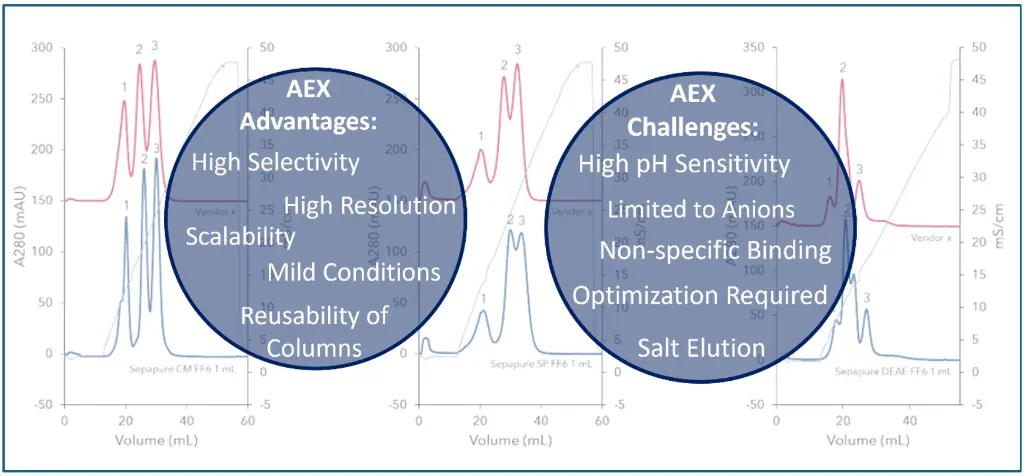
Figure 5: AEX Advantages and Challenges.
💡Charged and Separated: Final Thoughts on AEX for Oligonucleotide Analysis
Don´t be afraid of mastering AEX. With smart tuning of pH and salt, AEX turns into a precision tool for oligonucleotide separation, delivering sharp peaks, high resolution, and dependable results, even for the toughest sequences.
If you're planning to set up or optimize your oligonucleotide workflow, feel free to contact us at sales@knauer.net. Stay tuned for more exciting insights into the Oligonucleotide world in our “Oligos Made Easy” series.
For more in-depth discussion or questions, reach out to the author at kindler@knauer.net

